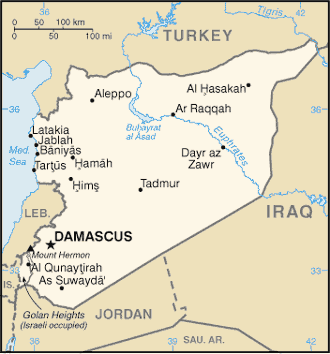
|
Syria
Background:
The French administered Syria following the breakup of the Ottoman Empire
during World War I, until independence in 1946. In the 1967 Arab-Israeli War,
Syria lost the Golan Heights to Israel. Since 1976, Syrian troops have been
stationed in Lebanon, ostensibly in a peacekeeping capacity. In recent years,
Syria and Israel have held occasional peace talks over the return of the Golan
Heights.
Location:
Middle East, bordering the Mediterranean Sea, between Lebanon and Turkey
Area: Total: 185,180 sq km. Note: includes 1,295 sq km of Israeli-occupied
territory, water: 1,130 sq km, land: 184,050 sq km.
Area - comparative: Slightly larger than North Dakota
Land boundaries: Total: 2,253 km border countries: Iraq 605 km, Israel 76 km,
Jordan 375 km, Lebanon 375 km, Turkey 822 km.
Coastline: 193 km.
Climate and Terrain:
Climate: Mostly desert; hot, dry, sunny summers (June to August) and mild,
rainy winters (December to February) along coast; cold weather with snow or
sleet periodically in Damascus.
Terrain: Primarily semiarid and desert plateau; narrow coastal plain; mountains
in west.
People:
Population: 17,155,814.
Ethnic groups: Arab 90.3%, Kurds, Armenians, and other 9.7%.
Religions: Sunni Muslim 74%, Alawite, Druze, and other Muslim sects 16%,
Christian (various sects) 10%, Jewish.
Languages: Arabic (official); Kurdish, Armenian, Aramaic, Circassian widely
understood; French, English somewhat understood.
Government:
Government type: Republic under military regime since March 1963.
Capital: Damascus.
Independence: 17 April 1946 (from League of Nations mandate under French
administration).
Economy overview:
Syria's predominantly statist economy has been growing slower than its 2.5%
annual population growth rate, causing a persistent decline in per capita GDP.
President Bashar AL-ASAD has made little progress on the economic front after
one year in office, but does appear willing to permit a gradual strengthening
of the private sector. His most obvious accomplishment to this end was the
recent passage of legislation allowing private banks to operate in Syria,
although a private banking sector will take years and further government
cooperation to develop. ASAD's recent cabinet reshuffle may improve his chances
of implementing further growth-oriented policies, although external factors
such as the international war on terrorism, the Israeli-Palestinian conflict,
and downturn in oil prices could weaken the foreign investment and government
revenues Syria needs to flourish.
Statistics:
Telephones - main lines in use: 1.313 million.
Radio broadcast stations: AM 14, FM 2, shortwave 1.
Radios: 4.15 million.
Television broadcast stations: 44 (plus 17 repeaters).
Televisions: 1.05 million.
Internet users: 60,000.
Railways: Total: 2,750 km.
Highways: Total: 41,451 km, paved: 9,575 km, unpaved: 31,876 km.
Airports: 99,
with paved runways: 24,
with unpaved runways: : 68
Heliports: 7.
Return to Visiting Locations
|

